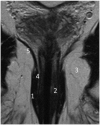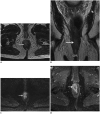Cancer of the Anal Canal: Diagnosis, Staging and Follow-Up with MRI
- PMID: 29089827
- PMCID: PMC5639160
- DOI: 10.3348/kjr.2017.18.6.946
Cancer of the Anal Canal: Diagnosis, Staging and Follow-Up with MRI
Abstract
Although a rare disease, anal cancer is increasingly being diagnosed in patients with risk factors, mainly anal infection with the human papilloma virus. Magnetic resonance imaging (MRI) with external phased-array coils is recommended as the imaging modality of choice to grade anal cancers and to evaluate the response assessment after chemoradiotherapy, with a high contrast and good anatomic resolution of the anal canal. MRI provides a performant evaluation of size, extent and signal characteristics of the anal tumor before and after treatment, as well as lymph node involvement and extension to the adjacent organs. MRI is also particularly helpful in the assessment of complications after treatment, and in the diagnosis for relapse of the diseases.
Keywords: Anal cancer; Anus; Diagnosis; Magnetic resonance imaging; Staging.
Figures












References
-
- American Joint Committee on Cancer. AJCC cancer staging manual. 7th ed. New York: Springer; 2010. pp. 103–106.
-
- Jemal A, Siegel R, Xu J, Ward E. Cancer statistics, 2010. CA Cancer J Clin. 2010;60:277–300. - PubMed
-
- Johnson LG, Madeleine MM, Newcomer LM, Schwartz SM, Daling JR. Anal cancer incidence and survival: the surveillance, epidemiology, and end results experience, 1973-2000. Cancer. 2004;101:281–288. - PubMed
-
- Uronis HE, Bendell JC. Anal cancer: an overview. Oncologist. 2007;12:524–534. - PubMed
-
- Hoots BE, Palefsky JM, Pimenta JM, Smith JS. Human papillomavirus type distribution in anal cancer and anal intraepithelial lesions. Int J Cancer. 2009;124:2375–2383. - PubMed
Publication types
MeSH terms
Substances
LinkOut - more resources
Full Text Sources
Other Literature Sources
Medical

